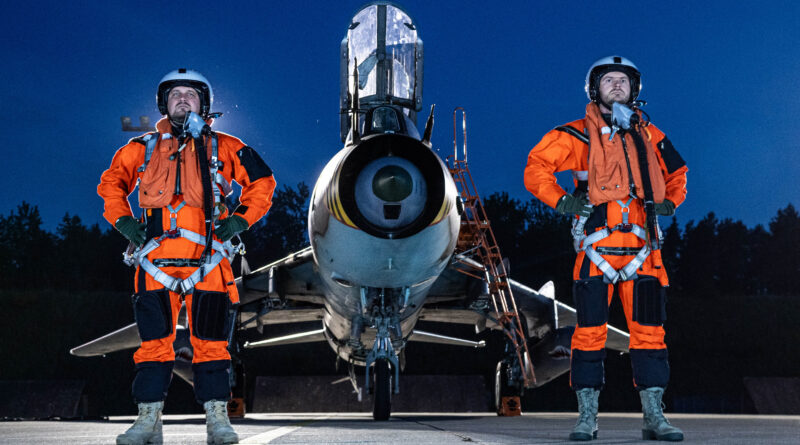Polish Air Force Officially Decommissions Su-22, Transitions to Western Hardware
This week marked the formal decommissioning of the venerable Su-22 Fitter fighter bomber by the Polish Air Force at an event held in Miros?awiec. Set in motion by a declaration from the Polish Armed Forces’ Head of the General Staff in March 2025, the removal of the Su-22 fleet from service has been on the horizon for a while. The introduction of the cutting-edge KAI FA-50 and the future deployment of F-35 Lightning IIs concretize Poland’s transition from reliance on Soviet and Russian military hardware. This switch was accelerated by the shortage of suitable military support due to the tense geopolitical developments with Russia’s incursion into Ukraine.
Looking forward, Polish military personnel are expected to use equipment built by NATO countries and their partners thus marking a significant strategic shift. Following the decommissioning of the Su-22, the MiG-29 is the only aircraft remaining in the Polish inventory with a distinct Russian lineage. An overhaul of the country’s helicopter fleet, originally of Soviet and Russian origin, is also in the pipeline.
The Mi-8 helicopters that have been a mainstay of the Air Force’s rotary fleet are slated to be replaced with a subsequent set of AW101 Merlin helicopters. Additionally, rumors suggest that the Polish Navy’s Mi-2 and Mi-14 helicopters could be heading for retirement as early as 2026.
The retirement ceremony commemorating the Su-22’s service included a formation flight conducted by three Su-22UM3K twin-seat planes flying across various sites in Poland with historical links to the Su-22. In Miros?awiec, single-seater Su-22M4 airplanes were exhibited with combat weaponry. Added interest was generated by the special flypast of an Su-22M4 equipped with an electronic intelligence (ELINT) and photo reconnaissance pod, specifically a KKR-1 unit.
At the height of its service, the Polish Air Force had over 100 Su-22s in operation. This number has slowly waned due to the introduction of contemporary aircraft and the outdated design of the Su-22, which had its maiden flight in 1966. The Su-22 represents an export version of the Su-17, which was the mainstay of the Soviet and Russian Air Forces between 1970 and 1998.
The Su-17 was originally developed to succeed the earlier Su-7 by Sukhoi. A cumulative production run spanning approximately 21 years saw nearly 3,000 Su-17, Su-20, and Su-22 aircraft being manufactured. Many of these were sold to nations within the Soviet Union’s orbit, with Afghanistan, Czechoslovakia, East Germany, Iraq among the customers.
The Su-22 continues to fly in Angola, Iran, Libya, Syria, Vietnam, and Yemen to this day, which is a testament to its durability and functionality. The retirement of the Su-22 from the Polish Air Force fleet coincided with a serious intrusion by Russian unmanned aerial vehicles (UAVs) into Polish airspace.
A number of drones reportedly crossed the Poland-Ukraine border under the cover of darkness, a majority of which were promptly intercepted. The Polish Prime Minister opined that the invasion by the drones wasn’t coincidental, but rather a calculated move by Russia to gauge Poland’s military preparedness and commitment in anticipation of further potential hostilities.
This incident underlines Poland’s urgent need to fortify its security forces, especially the air defense systems. Although acquisition of state-of-the-art defense equipment takes time due to existing industrial constraints, the need to respond swiftly to the increased demand has been realized.
Deployed as part of the Enhanced Baltic Air Policing mission, Dutch F-35As stood ready to intervene in the drone incidents, bolstered by an A330 Multi-Role Tanker Transport from the NATO fleet. The expected arrival of the F-35A in the coming years will undeniably enhance the Poland’s defense readiness.
Beyond just acquiring new aircraft, attention must shift towards developing vital counter unmanned aerial systems (C-UAS) technologies that can neutralize UAVs through either ‘soft kill’ or ‘hard kill’ measures. Advances in focused energy weaponry, such as lasers, may hold the keys to achieving this task.
The development of advanced radar systems and optical/infrared sensors specifically tailored to the smaller profile of UAVs is equally important to ensure early and effective detection of threats. The drone incursion has been a stark reminder that while Poland and NATO are on the right path, there is still substantial work ahead to fully adapt to modern warfare challenges.

